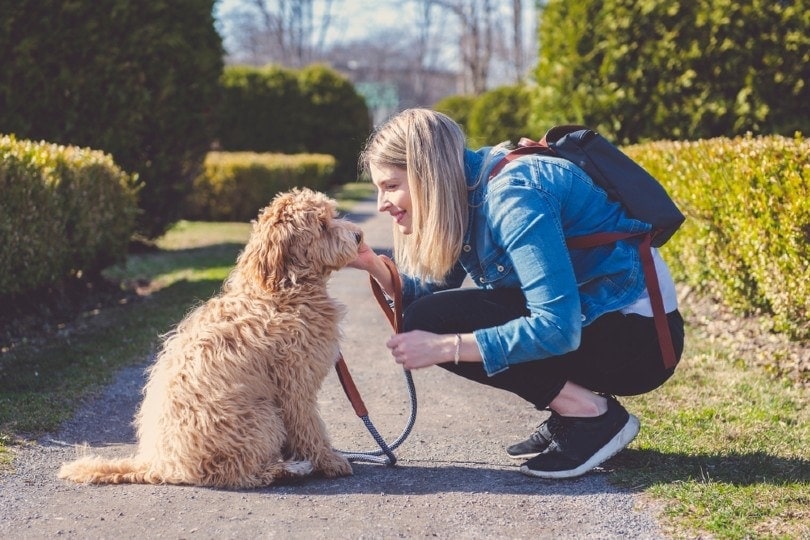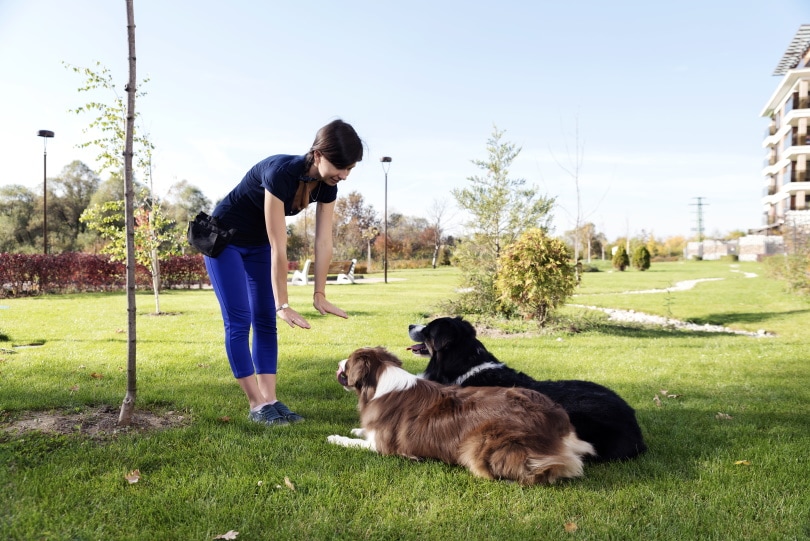
Dogs communicate through barking the same way we communicate with speech. It might get annoying for both the neighbors and those in your own household if your dog won’t stop barking at joggers, passersby, bikers, and every moving thing.
You might want to stop the behavior entirely if your dog is doing it out of curiosity, friendliness, aggression, or otherwise. After all, having a noisy animal can cause friction between you and the people who live next door.
Even though there’s no one-size-fits-all in the situation, there are ways that you can try to curb the behavior in a way that works out for everybody.
Identifying the Cause
It’s important to understand that there are different reasons why your dog is barking at other people. Based on those, the solutions might be different from scenario to scenario.
However, barking is also a regular part of your dog’s existence. To deprive them of being able to vocalize would be to take away one of their most basic instincts. So, while it might be annoying or upsetting to other people, silencing your dog is not the answer.

Why Dogs Bark
The 5 Tips to Stop Your Dog From Barking at Neighbors
Each dog is different, so coming up with a one-size-fits-all solution is really not possible. Your dog’s attitude says a lot. After you figure out the root cause of what makes your dog bark at the neighbors, there are steps that you can take to prevent it.
1. Get Them Acquainted With the Neighbors
One of the best ways to calm your dog down about those who live around you is to let them get to know each other. With your neighbor’s permission, you can introduce them to one another and let them meet. It’s a good idea to allow them to visit each house so they can understand the separation of families and territories.
Once they grow acclimated to your neighbor personally, they will feel less threatened by them and might stop barking entirely. If your neighbor remains a stranger on the other side of the fence their whole life, they might always perceive them as a potential threat or an unattainable playmate.
Granted, not all neighbors are the best troopers. Some might have no interest in meeting your dog, and others might even be afraid of them. If that’s the case, you’ll have to come up with other means to quiet your dog down while making your neighbors feel secure.

2. Be Close By
If you have a fenced-in backyard, you probably let your dogs come in and out as needed. The convenience of having a fenced-in yard is that you don’t have to stand outside with them while they do their business.
However, if your dog is obsessively barking at the neighbors, you might stand outside to monitor the situation. Sometimes, the comfort of having an owner close by will relax them enough to quiet them down.
Of course, this isn’t always possible. After all, you have a schedule and tasks that deserve your attention. But if you notice your neighbor outside when possible, stay on standby to correct any mishaps.
3. Promote Healthy Exercise
Is your dog getting enough exercise? One of the hallmark reasons a dog barks at your neighbor or anyone else is that they’re just bored. They see activity happening outside and want to be a part of it.
Depending on the breed, certain dogs can require up to two hours of strenuous exercise per day. If they lack appropriate activity, pent-up energy can cause quite a display of behavioral concerns. Ensure that your dog is getting the proper exercise to avoid these issues.
Lack of exercise can result in several unwanted new habits aside from excessive barking, such as property destruction, lack of obedience, rough play, and other signs of hyperactivity. If your dog doesn’t have another playmate, it’s even more challenging to make sure they’re getting the appropriate amount of exercise.
If you can’t be there to play with your dog, you can get them interactive toys and games or even consider getting them a friend. Adoption centers across the world will thank you.

4. Train With Treats
You can manipulate dog behavior quite a bit using the power of food. All dogs love a juicy snack for a job well done. If you want to self-train, you can work with your dog, correct the behavior each time the barking starts, and reward them with a treat if they behave.
Granted, this will take some patience, consistency, and routine scheduling. Each time they act, it has to have the same reward and effect, so the consequence is apparent each time. If you have the time to dedicate to training your dog, you will be surprised by how far you can get.
However, this doesn’t mean that the barking stops completely. Dogs are still dogs and will still bark if there is a trigger. However, you can channel their energy a bit, knowing that the neighbors are off-limits and there’s no need to alarm the household.
5. Opt for Obedience Training
Obedience training doesn’t fit in everyone’s budget. Luckily, most owners don’t know that everything an obedience trainer teaches your dog, you’re more than capable of doing yourself.
Any good trainer will tell you that the training long exceeds any program, counting on the owners to keep up with the teachings after they come home.
If you enroll your dog, the obedience trainer can give you the basic commands to teach them when and where it is not appropriate to bark. But you and your family have to be ready, as you will have to do the hard work at your house.
So, if you can do your own research or follow through in an obedience class, you might be able to teach your dog by vocal commands or even whistles. These cues let them know that their behaviors are unwanted and should stop.
Each trainer has their own methods, and some may or may not work for your dog. However, if you pick the most compatible trainer, you can notice a significant improvement in these behaviors.

The “Don’ts”
That is all great, but what about the things you shouldn’t do? Here are some definite ways not to handle the situation.
Shock Collars
Shock collars are readily available in the marketplace. Many owners use shock collars to teach wanted results or eliminate bad behaviors through mild electrocution. While this might be recommended to some people or seem like a suitable solution, we disagree.
According to the BCSPCA, though it is widely encouraged by pet stores and professional trainers, shock collars are inhumane. It focuses on a fear-based learning style, which can have repercussions, especially considering the dog’s breed or circumstances.
Shock collars may seem like a faster solution, but it creates a long-term problem with some pets. Essentially, your dog is learning that they are negatively impacted or punished
anytime they use their voice.
If you had an intruder coming into your home, you’d want them to be on high alert. But if they’re afraid to notify you, it could make them hesitate to alert you in a real emergency.
So, while it might be tempting to get a quick result, long-term training and other obedience practices are much more humane and efficient.
Negative or Harsh Punishments
Dogs are sensitive creatures that pick up very much on our emotional cues. When you have a bad day, you might notice that your dog comes over and lays a paw or chin on your lap as a means of comfort.
So, even though it might be challenging to deal with the same issue day after day, punishing your dog harshly is not the answer. Dogs do not respond well to hitting, screaming, or negative connotations.
They will develop a sense of fear around you, which always makes them slightly reserved. It can also trigger submissive behaviors like urination.
If your dog is trying to communicate with a neighbor and you are ridiculing and even physically hurting them, it might only worsen the behavior and damage the relationship between you and your dog.
There are always alternative solutions, and every dog is trainable. So, proper handling of the situation is vital.
Last Resort Options
Situations happen, and even though people might get shamed for rehoming pets, the reality is that sometimes it’s the best solution. If you’re in a predicament causing major conflict between you and your neighbors, or you feel wholly inadequate after exhausting all avenues—it’s time to decide.
If it comes down to life-impacting stuff, another family out there with different circumstances can give your dog the life they need. There are appropriate steps to take to ensure your pet’s safety and best future.
In those extreme situations that are very uncommon, we want to stress this is an absolute last-resort option. If you find yourself in this position, there are plenty of resources, so don’t be afraid to check in your local areas. You can also ask your veterinarian for recommendations.

Conclusion
Your dog constantly barking at your neighbor can be very annoying, but that’s usually the worst of it. However, there’s a chance that the barking could cause more conflict between you and your neighbors.
Try out a couple of tips on this list to make sure you’re doing all you can to make all parties involved happy. Getting your pup on the right track shouldn’t take too much time or creativity! Stay proactive, and best of luck.
Featured Image Credit: Jne Valokuvaus, Shutterstock








